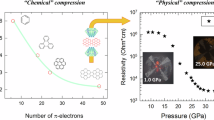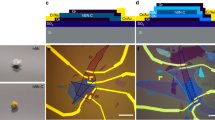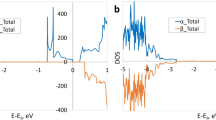Abstract
An elusive conductor with perfect optical transparency holds revolutionary potential for fields such as optoelectronics and nanophotonics. Such a hypothetical metal would possess a spectral gap1,2—a ‘hyper-gap’—in its absorption spectrum, separating the intraband and interband absorptions, in which optical losses could vanish. Currently, this property is achievable only within the bandgap of insulators. However, realizing such a hyper-gap metal demands an exotic electronic structure in which the conducting bands have a bandwidth narrower than their energy separations from the remaining electronic states. Here we present such a hyper-gap in a family of organic metals—the Fabre charge-transfer salts3—through first-principles predictions coupled with both electrical and optical measurements. A transparent window, spanning from red to near-infrared wavelengths, is identified in bulk single crystals that remain transmissive over a thickness of 30 µm. The corresponding absorption coefficient is the lowest among known stoichiometric metals, rivalling thin films of transparent conductive oxides. This finding introduces a path, beyond traditional doping strategies in insulators, to combine electronic conduction and optical transparency.
This is a preview of subscription content, access via your institution
Access options
Access Nature and 54 other Nature Portfolio journals
Get Nature+, our best-value online-access subscription
$32.99 / 30 days
cancel any time
Subscribe to this journal
Receive 12 print issues and online access
$259.00 per year
only $21.58 per issue
Buy this article
- Purchase on SpringerLink
- Instant access to full article PDF
Prices may be subject to local taxes which are calculated during checkout




Similar content being viewed by others
Data availability
The data presented in the main text are available via Zenodo at https://doi.org/10.5281/zenodo.15228102 (ref. 37). All other data are available from the corresponding author on reasonable request.
References
Medvedeva, J. E. & Freeman, A. J. Combining high conductivity with complete optical transparency: a band structure approach. Europhys. Lett. 69, 583–587 (2005).
Khurgin, J. B. & Sun, G. In search of the elusive lossless metal. Appl. Phys. Lett. 96, 181102 (2010).
Parkin, S. et al. Superconductivity in the organic charge transfer salts: (TMTSF)2X and (TMTTF)2X. Mol. Cryst. Liq. Cryst. 79, 605–615 (1982).
Mitra, S. S. & Bendow, B. (eds.) Optical Properties of Highly Transparent Solids (Springer, 1975).
Ginley, D. S. (ed.) Handbook of Transparent Conductors (Springer, 2011).
Malyi, O. I. & Zunger, A. False metals, real insulators, and degenerate gapped metals. Appl. Phys. Rev. 7, 041310 (2020).
Zhang, X., Zhang, L., Perkins, J. D. & Zunger, A. Intrinsic transparent conductors without doping. Phys. Rev. Lett. 115, 176602 (2015).
Gjerding, M. N., Pandey, M. & Thygesen, K. S. Band structure engineered layered metals for low-loss plasmonics. Nat. Commun. 8, 15133 (2017).
Wang, G. et al. Design of intrinsic transparent conductors from a synergetic effect of symmetry and spatial-distribution forbidden transitions. Phys. Rev. Lett. 134, 036401 (2025).
Hu, X. et al. High-throughput search for lossless metals. Phys. Rev. Mater. 6, 065203 (2022).
Jérome, D. The physics of organic superconductors. Science 252, 1509–1514 (1991).
Jacko, A. C. et al. Electronic properties of Fabre charge-transfer salts under various temperature and pressure conditions. Phys. Rev. B 87, 155139 (2013).
Korin-Hamzić, B., Tafra, E., Basletić, M., Hamzić, A. & Dressel, M. Conduction anisotropy and Hall effect in the organic conductor (TMTTF)2AsF6: evidence for Luttinger liquid behavior and charge ordering. Phys. Rev. B 73, 115102 (2006).
Korzeb, K., Gajc, M. & Pawlak, D. A. Compendium of natural hyperbolic materials. Opt. Express 23, 25406–25424 (2015).
Farges, J.-P. Organic Conductors: Fundamentals and Applications 138–140 (CRC Press, 1994).
Dressel, M. et al. Charge and spin dynamics of TMTSF and TMTTF salts. Synth. Met. 120, 719–720 (2001).
Köhler, B., Rose, E., Dumm, M., Untereiner, G. & Dressel, M. Comprehensive transport study of anisotropy and ordering phenomena in quasi-one-dimensional (TMTTF)2X salts (X = PF6, AsF6, SbF6, BF4, ClO4, ReO4). Phys. Rev. B 84, 035124 (2011).
Itoi, M., Araki, C., Hedo, M., Uwatoko, Y. & Nakamura, T. Anomalously wide superconducting phase of one-dimensional organic conductor (TMTTF)2SbF6. J. Phys. Soc. Jpn 77, 023701 (2008).
Naik, G. V., Shalaev, V. M. & Boltasseva, A. Alternative plasmonic materials: beyond gold and silver. Adv. Mater. 25, 3264–3294 (2013).
Vescoli, V., Degiorgi, L., Starkey, K. P. & Montgomery, L. K. Anisotropy in the optical response of (TMTTF)2X (X=PF6 and Br) Bechgaard salts. Solid State Commun. 111, 507–512 (1999).
Poddubny, A., Iorsh, I., Belov, P. & Kivshar, Y. Hyperbolic metamaterials. Nat. Photon. 7, 948–957 (2013).
Jellison, G. E., Podraza, N. J. & Shan, A. Ellipsometry: dielectric functions of anisotropic crystals and symmetry. J. Opt. Soc. Am. A 39, 2225–2237 (2022).
Fujiwara, H. Spectroscopic Ellipsometry: Principles and Applications 137–138 (John Wiley & Sons, 2007).
Johnson, P. B. & Christy, R. W. Optical constants of the noble metals. Phys. Rev. B 6, 4370–4379 (1972).
Yang, H. U. et al. Optical dielectric function of silver. Phys. Rev. B 91, 235137 (2015).
Secondo, R., Khurgin, J. & Kinsey, N. Absorptive loss and band non-parabolicity as a physical origin of large nonlinearity in epsilon-near-zero materials. Opt. Mater. Express 10, 1545–1560 (2020).
Zhang, C. et al. Unraveling Urbach tail effects in high-performance organic photovoltaics: dynamic vs static disorder. ACS Energy Lett. 7, 1971–1979 (2022).
Ugur, E. et al. Life on the Urbach edge. J. Phys. Chem. Lett. 13, 7702–7711 (2022).
Khusayfan, N. M. & El-Nahass, M. M. Study of structure and electro-optical characteristics of indium tin oxide thin films. Adv. Condens. Matter Phys. 2013, e408182 (2013).
Smith, N. V. Optical constants of sodium and potassium from 0.5 to 4.0 eV by split-beam ellipsometry. Phys. Rev. 183, 634–644 (1969).
Graja, A. Low-Dimensional Organic Conductors (World Scientific, 1992).
Xie, L. S., Skorupskii, G. & Dinca, M. Electrically conductive metal–organic frameworks. Chem. Rev. 120, 8536–8580 (2020).
Eshaghi, A. & Graeli, A. Optical and electrical properties of indium tin oxide (ITO) nanostructured thin films deposited on polycarbonate substrates ‘thickness effect’. Optik 125, 1478–1481 (2014).
Momma, K. & Izumi, F. VESTA 3 for three-dimensional visualization of crystal, volumetric and morphology data. J. Appl. Cryst. 44, 1272–1276 (2011).
Hafner, J. Ab-initio simulations of materials using VASP: density-functional theory and beyond. J. Comput. Chem. 29, 2044–2078 (2008).
Heyd, J., Scuseria, G. E. & Ernzerhof, M. Hybrid functionals based on a screened Coulomb potential. J. Chem. Phys. 118, 8207–8215 (2003).
Wu, Z. Dataset: hyper-gap transparent conductor. Zenodo https://doi.org/10.5281/zenodo.15228102 (2025).
Acknowledgements
We thank X. Wang, S. Gao, T. Qian, G. Miao and B. Liu for helpful discussions. This work was supported by the Natural Science Foundation of China (12025409) and by the Chinese Academy of Sciences through the Project for Young Scientists in Basic Research (YSBR-021), the Strategic Priority Research Program (XDB33000000) and the IOP-HKUST-Joint Laboratory for Wave Functional Materials Research. A portion of this work was carried out at the Synergetic Extreme Condition User Facility (SECUF) and the Laboratory of Microfabrication, IOP CAS.
Author information
Authors and Affiliations
Contributions
Z.W. performed the DFT calculations with the help of X.H.; conducted the crystal synthesis with the help of C.L.; conducted the electrical measurements; performed various optical measurements and analysis with the help of Y.L., X.G. and K.C.; and wrote the manuscript with L.L. who supervised the entire project.
Corresponding author
Ethics declarations
Competing interests
The authors declare no competing interests.
Peer review
Peer review information
Nature Materials thanks Kazushi Kanoda and Jacob Khurgin for their contribution to the peer review of this work.
Additional information
Publisher’s note Springer Nature remains neutral with regard to jurisdictional claims in published maps and institutional affiliations.
Extended data
Extended Data Fig. 1 DFT results of (TMTTF)2X with different anions X = SbF6, PF6, AsF6 and BF4.
a, Band structure. Eintra: the bandwidth of the metallic band; Einter: the distance from Fermi energy EF to the band maximum of bands below -2 eV; Δℏω: the width of the hyper-gap. b, The dependence of Eintra, Einter, Δℏω, and the effective mass m* (me is the free electron mass) on different anions.
Extended Data Fig. 2 Density of states (DOS) and Partial density of states (PDOS) of (TMTTF)2SbF6.
PDOS for s, p, d orbitals are contributed from different atoms.
Extended Data Fig. 3 (TMTTF)2SbF6 samples under the microscope.
a, Samples illuminated by white light from front side. b, Samples illuminated by white light from back side.
Extended Data Fig. 4 Polarization dependent transmittance of 6.5 μm-thick (TMTTF)2SbF6.
a, Transmittance spectra from 0° to 90° polarization. b, Transmittance spectra from 90° to 180° polarization.
Extended Data Fig. 5 Experimental electrical and optical properties of (TMTTF)2X with different anions X = SbF6, PF6, AsF6 and BF4 at room temperature.
a, σ: conductivity along x direction; μ: carrier mobility. μ is derived from σ and calculated carrier density n using μ = σ/(ne). b, optical properties with x and y polarized incident light, extracted from Supplementary Fig. 4. α: lowest absorption coefficient; EU,intra and EU,inter: Urbach energies of the two tails (lower and higher energy sides) of the absorption spectra.
Supplementary information
Supplementary Information
Supplementary Notes 1–6, Figs. 1–9, Table 1 and discussion.
Rights and permissions
Springer Nature or its licensor (e.g. a society or other partner) holds exclusive rights to this article under a publishing agreement with the author(s) or other rightsholder(s); author self-archiving of the accepted manuscript version of this article is solely governed by the terms of such publishing agreement and applicable law.
About this article
Cite this article
Wu, Z., Li, C., Hu, X. et al. Hyper-gap transparent conductor. Nat. Mater. 24, 1387–1392 (2025). https://doi.org/10.1038/s41563-025-02248-0
Received:
Accepted:
Published:
Issue date:
DOI: https://doi.org/10.1038/s41563-025-02248-0



